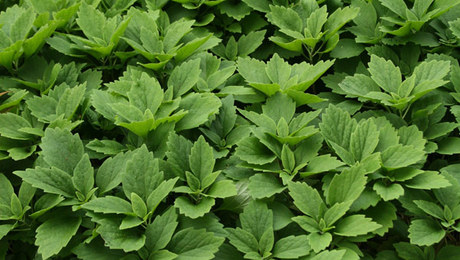If you know the genus and species of this month’s mystery plant, you could win a free one-year subscription to Fine Gardening. Send your entry, along with your complete mailing address, by May 31, 2009 to [email protected]. The winner will be chosen at random from all correct entries.
Do you have a plant in your garden that you can’t identify? Take a photo, post it in our new
Mystery Plant
gallery, and hopefully another gardener will come along and help you out.
Last month’s mystery plant was Calendula officinalis, commonly known as the pot marigold. From mid-summer to autumn, this annual plant has daisy-like flowers of pale, sunny yellow to deep orange, in both single and double forms. Pot marigolds grow up to 30 inches tall and 18 inches wide, though most are a bit shorter, and they prefer full sun and fertile, well-drained soil. The flowers are edible, and the petals make a lively addition to tossed salads and veggie dips. Sandy Hanger of Weyers Cave, Virginia, was chosen at random from all correct entries to receive a free one-year subscription to Fine Gardening. Congratulations, Sandy!
What eLetter subscribers have to say about Calendula officinalis:
“I love this cheery orange flower, but they don’t seem to last well in my garden. Perhaps not enough sun.”
-Edie Moro, Cheshire, Oregon
“I have these growing right now!! Like them a lot!”
-Bev Traenkle, Campbell, California
“We always have it growing in our garden. It is a bright color spot and the petals are perfect to enliven a salad or brighten any recipe. Try it in scones and enjoy the golden petal specks.”
-Jessie Adams, Wilsonville, Oregon
“I love this plant and it is all over my garden. Soooo easy and sooo beautiful.”
-Ellen A. Hall, Santa Ynez, California
“I’ve grown it for 25 years from seed I brought home from England. The original seeds grew gangbusters and have been reseeding since then. I make lemon-calendula bars. They’re so pretty. And tasty, too!
-Jackie Flaherty, St. Paul, Minnesota
“This plant grew very well for me when I lived in Connecticut. In Virginia where I now live, it does well early in the growing season but peters out when the heat and humidity arrive. I can prolong its productive time by growing it in a less sunny spot. By growing it in pots, I can move them around to shield them from the hot sun.”
-Teresa Festa, Manakin Sabot, Virginia
“I know this plant is used for its medicinal properties, as well as in cosmetic products.”
-Claudia Wong, Houston, Texas
“I have 100s of them in my garden every year. The flowers are edible and beautify every salad, and I use the dried petals for tea.”
-Ursula Schrader, Verden, Germany
“It used to reseed itself in my previous garden. The dried petals were mixed in with other herbs for a health tea. Thank you for reminding me! I do need to grow this delightful flower again!”
-Liselotte Hirsbrunner, Chesieres, Switzerland
“I have grown these for years. They reseed themselves and bloom all summer until frost. I love them in my garden, and they make beautiful short bouquets, too.”
-Hope Koehler, Menomonee Falls, Wisconsin
“I love it, but have not had much luck with it in my own garden.”
-Mary Chapman, Allen Park, Michigan
“It seeds itself and grows wild in my garden in lovely shades of yellow and orange. Also the petals are edilbe and make a colourful addition to salads.”
-Deb Melnyk, Chemainus, British Columbia, Canada
“I like to grow it with my veggies. It’s easy and a reliable self-seeder that brings the polinators around. They are just so cheery looking, also. A winner all around.”
-Dawn Beat, Merritt, British Columbia, Canada
“I have had this plant growing in my garden for years. It’s one of my favorites.
-Natalia Godlewski, Kitchener, Ontario, Canada
“In German it is called “Ringelblume” because the seeds are curved.”
-Mrs. Ines Ende, Singen, Germany















Comments
Log in or create an account to post a comment.
Sign up Log in